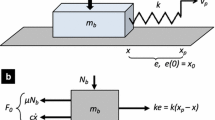Abstract
We propose and evaluate a linearized method to measure dynamic friction between micromachined surfaces. This linearized method reduces the number of data points needed to obtain dynamic friction data, minimizing the effect of wear on sliding surfaces during the measurement. We find that the coefficient of dynamic friction is lower than the coefficient of static friction, while the adhesive pressure is indistinguishable for the two measurements. Furthermore, after an initial detailed measurement is made on a device type, the number of trial runs required to take the data on subsequent devices can be reduced from 200 to approximately 20.






Similar content being viewed by others
References
Sniegowski JJ, de Boer MP (2000) IC-compatible polysilicon surface micromachining. Annu Rev Mater Sci 30:297.
Chau KHL, Sulouff RE (1998) Technology for the high-volume manufacturing of integrated surface-micromachined accelerometer products. Microelectron J 299:579.
Schuster J, Monk D (2000) Micromachined pressure sensors pave way for new process solutions. Control Solut 7311:43.
Tanner DM, Dugger MT (2003) Wear mechanisms in a reliability methodology. In: Proc. of the SPIE, vol. 4980, pp 22–40.
Hornbeck LJ (1995) Projection displays and MEMS: timely convergence for a bright future. In: Proc. of the SPIE, vol. 2639. Austin, TX, pp 2–12.
Henck SA (1997) Lubrication of digital micromirror devices. Tribol Lett 3:239.
Ashurst WR, Yau C, Carraro C, Maboudian R, Dugger MT (2001) Dichlorodimethylsilane as an anti-stiction monolayer for MEMS: a comparison to the octadecyltrichlosilane self-assembled monolayer. J Microelectromech Syst 101:41.
Tas NR, Gui C, Elwenspoek M (2003) Static friction in elastic adhesion contacts in MEMS. J Adh Sc Tech 174:547.
Timpe SJ, Komvopoulos K (2006) The effect of adhesion on the static friction properties of sidewall contact interfaces of microelectromechanical devices. J Microelectromech Syst 156:1612.
Alsem DH, Stach EA, Dugger MT, Enachescu M, Ritchie RO (2007) An electron microscopy study of wear in polysilicon microelectromechanical systems in ambient air. Thin Solid Films 5156:3259.
Lim MG, Chang JC, Schultz DP, Howe RT, White RM (1990) Polysilicon microstructures to characterize static friction. In: Proc. IEEE MEMS Workshop. Napa Valley, CA, USA, pp 82–88.
Corwin AD, de Boer MP (2004) Effect of adhesion on dynamic and static friction in surface micromachining. Appl Phys Lett 8413:2451.
Eapen KC, Smallwood SA, Zabinski JS (2006) Lubrication of MEMS under vacuum. Surf Coat Tech 2016:2289.
Gabriel KJ, Behi F, Mahadevan R, Mehregany M (1990) In situ friction and wear measurements in integrated polysilicon mechanisms. Sens Actuators, A A21–A23:184.
Turner KL, Hartwell PG, Macdonald NC (1999) Multi-dimensional MEMS motion characterization using laser vibrometry. In: Transducers ’99 The 10th International Conference on Solid-State Sensors and Actuators. Sendai, Japan, pp 1144–1147.
de Boer MP, Luck DL, Ashurst WR, Corwin AD, Walraven JA, Redmond JM (2004) High-performance surface-micromachined inchworm actuator. J Microelectromech Syst 131:63.
Tang WC, Nguyen TCH, Howe RT (1989) Laterally driven polysilicon resonant microstructures. Sens Actuators A 201–2:25.
Miller SL, Rodgers MS, La Vigne G, Sniegowski JJ, Clews PJ, Tanner DM, Peterson KA (1999) Failure modes in surface micromachined microelectromechanical actuation systems. Microelectron Reliab 398:1229.
Greenwood JA, Williamson JBP (1966) Contact of nominally flat surfaces. Proc Roy Soc Lond A 295:300.
Hankins MG, Resnick PJ, Clews PJ, Mayer TM, Wheeler DR, Tanner DM, Plass RA (2003) Vapor deposition of amino-functionalized self-assembled monolayers on MEMS. In: Proceedings of the SPIE, vol. 4980. San Francisco, pp 238–247.
Mayer TM, de Boer MP, Shinn ND, Clews PJ, Michalske TA (2000) Chemical vapor deposition of fluoroalkylsilane monolayer films for adhesion control in microelectromechanical systems. J Vac Sci Technol, B 185:2433.
Coulomb CA (1785) The theory of simple machines (in French). Mem Math Phys Acad Sci 10:161–331.
DelRio FW, de Boer MP, Knapp JA, Reedy ED, Clews PJ, Dunn ML (2005) The role of van der Waals forces in adhesion of micromachined surfaces. Nature Materials 48:629–634.
Acknowledgments
Sandia is a multiprogram laboratory operated by Sandia Corporation, a Lockheed Martin Company, for the United States Department of Energy under Contract DE-AC04-94AL85000.
Author information
Authors and Affiliations
Corresponding author
Rights and permissions
About this article
Cite this article
Corwin, A.D., de Boer, M.P. A Linearized Method to Measure Dynamic Friction of Microdevices. Exp Mech 49, 395–401 (2009). https://doi.org/10.1007/s11340-008-9158-9
Received:
Accepted:
Published:
Issue Date:
DOI: https://doi.org/10.1007/s11340-008-9158-9




